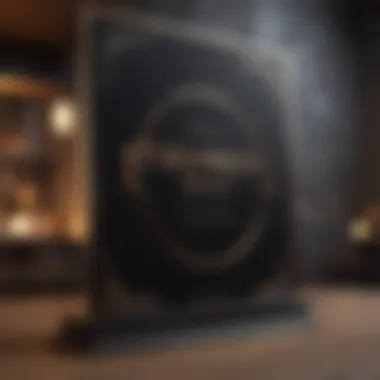Crafting an Effective Thank You for Your Purchase Template


Intro
In an age where customer loyalty is increasingly elusive, crafting a sincere and well-thought-out 'Thank You for Your Purchase' template can be the linchpin that holds strong customer relationships together. It serves not just as a polite gesture but as a critical touchpoint that can shape a customer's perception of a brand. This guide will explore various facets of creating an impactful template, including essential design elements, personalization techniques, and strategic insights into customer relationship management.
By engaging customers at the right moment, businesses can lay the groundwork for future sales and referrals. As we journey through this process, we will uncover the core concepts that can enhance an entrepreneur’s approach to customer communication.
Entrepreneurial Insights
Navigating the entrepreneurial landscape requires a foundation of insightful strategies. Creating a memorable 'Thank You for Your Purchase' template is merely a cog in the larger wheel of customer engagement. Every interaction matters, and in today’s competitive marketplace, this interaction can distinguish a thriving business from one that languishes.
Entrepreneurial Success Stories
Countless entrepreneurs have successfully leveraged the power of gratitude in nurturing their customer base. For instance, a local coffee shop owner, who sends handwritten notes with every order, not only sees repeat patrons but also earns referrals through word-of-mouth. Such personal touches resonate deeply, illustrating an understanding that money is not the only currency; appreciation holds value, too.
Challenges Faced by Entrepreneurs
It's not all smooth sailing. Entrepreneurs often grapple with the challenge of standing out amidst a saturated market. Crafting a template that fits one’s brand identity while staying relevant to the customer is daunting. Balancing professionalism with a touch of warmth can also be tricky. The key is to find a voice that communicates authenticity without coming off as robotic.
Tips for Aspiring Entrepreneurs
For those just starting out, consider these guiding principles:
- Know Your Audience: Tailor your template to address the specific demographics of your clientele.
- Keep It Simple: Clarity is king. A complicated message can detract from your intended purpose.
- Be Authentic: Let your brand personality shine through. Authentic messages resonate more than boilerplate responses.
CRM Strategies
As customer relationship management becomes increasingly vital to business success, understanding its intricacies can be a game changer. Integrating CRM strategies within the context of your 'Thank You for Your Purchase' template can enhance customer interactions.
Importance of CRM in Business
CRM systems help businesses track customer interactions and provide crucial insights into buying behaviors. By utilizing this data, you can personalize your follow-ups, thus creating an enduring relationship with your customers.
Choosing the Right CRM Software
Not all CRM tools are created equal. Selecting one that aligns with your business goals is essential. Popular options include Salesforce, HubSpot, and Zoho, each offering unique features tailored to various business needs. Consider scalability, user-friendliness, and available integrations when making your choice.
Implementing CRM Best Practices
To derive maximum benefit from your CRM, always ensure:
- Regular updates to customer information
- Analysis of customer feedback
- Strategic follow-ups based on customer engagement patterns
Business Sales Techniques
Effective sales techniques encompass much more than just closing deals; they involve fostering relationships that thrive over time. A carefully crafted 'Thank You' note can effortlessly segue into building rapport, thus paving the way for continual business.
Sales Strategies for Small Businesses
Small businesses often rely on relationship-building as a means of sustainable sales. Techniques such as referral incentives or loyalty programs can be effectively complemented by personalized thank-you communications.
Effective Sales Communication Skills
To enhance your communication, practice active listening. Understanding customer needs not only aids in crafting a great template but also enriches sales dialogues.
Closing Deals and Negotiation Tips
Being gracious and appreciative in your deals can lead to favorable negotiations. Reminder: even at the sale's conclusion, expressing gratitude can shift perceptions and facilitate smoother transactions next time.
Industry Trends and Analysis
An awareness of industry trends helps steer an entrepreneur's actions on how to communicate effectively with customers. Having an agile approach is essential when adapting the template to emerging patterns.
Market Trends Impacting Entrepreneurs
Currently, sustainability has become a major trend. Incorporating eco-friendly communication—like online thank-you notes instead of paper—can resonate well with environmentally-conscious consumers.
Data-driven Insights for Successful Sales
Utilizing data analytics can inform your approach effectively. Understanding when customers are most receptive can guide the timing of your thank-you messages, potentially increasing engagement and developing loyalty.
Case Studies and Real-life Examples
Consider businesses that have put theory into practice.
Real-world Examples of CRM Integration
A subscription box company bolstered its customer retention rates significantly after switching to a customer-centric CRM. Personalized thank-you emails, informed by customer profiles, resulted in a remarkable increase in repeat purchases.
Successful Sales Campaign Case Studies


Numerous campaigns leveraged gratitude-driven follow-ups to boost conversions. A well-known online retailer ran a campaign where customers received timely thank-you emails post-purchase, leading to a notable bump in upselling opportunities.
"Customers may forget what you said, but they will never forget how you made them feel."
By weaving these insights into your 'Thank You for Your Purchase' template, you’re poised to not just sell a product, but to cultivate a relationship that resonates long after a purchase has been completed.
Understanding the Importance of Thank You Messages
In today's competitive marketplace, it can be easy to overlook the small gestures that make all the difference in customer relationships. One such gesture is the simple yet powerful thank you message. Understanding its significance is essential for businesses, as these messages can transform a one-time buyer into a loyal customer. It’s not just about saying thank you; it's about forging connections and nurturing relationships that can withstand the test of time.
Thank you messages serve multiple purposes:
- Show Gratitude: First and foremost, they express gratitude. When a customer chooses your product or service, acknowledging that choice is fundamental in building rapport. A heartfelt thank you reinforces their decision to buy from you and helps them feel valued.
- Enhance Customer Experience: Secondly, these messages amplify the overall customer experience. After making a purchase, a customer may feel a sense of excitement, and receiving a thank you can heighten that feeling. It adds a personal touch that makes them feel more than just a transaction.
- Encourage Engagement: Further, thank you messages can encourage a customer to engage with your brand on a deeper level. Incorporating questions or prompts can lead them to share feedback or reviews. This engagement is critical in understanding customer satisfaction and improving service.
In addition to these points, it’s crucial to recognize that thank you messages can significantly impact customer retention. They are not just an afterthought but a strategic element in a broader marketing approach. In the sections to follow, we will explore specific aspects of this importance, focussing first on the role of gratitude in customer relationships.
The Role of Gratitude in Customer Relationships
Gratitude plays a pivotal role in nurturing customer relationships. When customers feel appreciated, their likelihood to return often increases. It’s a simple act that fosters loyalty. Moreover, gratitude can soften the sharp edges of any negatives that may arise in the customer experience. If they encounter issues, a company that expresses gratitude is often viewed favourably, even in less-than-ideal situations.
Studies have suggested that when companies initiate gratitude, there can be an uptick in positive sentiment towards the brand. When a customer feels compelled to return due to an emotional connection, this emotional return can often lead to constructive word-of-mouth, serving as invaluable marketing. Consider this: often, people remember not just what you said or did, but how you made them feel. Gratitude makes them feel valued, ensuring your message resonates, long after the purchase.
Impact on Customer Retention
Customer retention is a critical factor for any business’s success. When analyzing how thank you messages influence this, the data often reveals interesting patterns. Customers are likely to return to businesses that acknowledge them. A seamless experience, combined with a thank you note, can lead to increased loyalty and a return customer rate that’s noticeably higher.
In practice, strong retention strategies typically include adequate follow-up communication. Studies indicate that brands that successfully reach out with thank you messages can see retention rates spike. A few noteworthy benefits include:
- Repeat Business: When customers feel valued, they are more often inclined to return to your business, which directly translates to repeat sales.
- Increased Customer Lifetime Value: The longer a customer stays with your business, the greater their total purchase potential becomes.
- Community Building: Satisfied customers can act as ambassadors for your brand, creating a community of loyal supporters that organically fosters new customer acquisition.
By comprehending the importance of thank you messages and their undeniable link to customer loyalty and retention, businesses can leverage this knowledge to craft messages that truly resonate with their audience. A thoughtful message can serve as the initial thread that weaves a strong fabric of customer relationships.
Key Elements of an Effective Template
Creating an effective 'Thank You for Your Purchase' template isn’t just an afterthought; it's a vital piece of the customer relationship puzzle. Properly crafted messages can leave a lasting impression and set the stage for future interactions. Let's dig into the important aspects that make up such a template, focusing on the core elements, benefits, and factors to consider.
Clear and Concise Language
When writing a thank you message, simplicity is key. Using clear and straightforward language ensures that your customers understand your message without getting lost in jargon or complex sentences. Think of it this way: would you rather read a lengthy dissertation or a straightforward note that gets right to the point?
A few tips to keep in mind include:
- Seek brevity: Make your message short and sweet, so customers can digest the main points quickly.
- Avoid fluff: Ditch unnecessary words that don’t add value. Instead, focus on delivering a clear and meaningful expression of gratitude.
- Use active voice: Active voice makes your writing more direct and engaging. For example, instead of saying “Your purchase was appreciated,” say “We appreciate your purchase.”
This approach not only conveys your message effectively but also respects your customer's time and attention.
Personalization Techniques
Personalization goes a long way in making your customers feel valued. A template that simply mass-mails a thank you note lacks impact and may come off as disingenuous. Utilizing specific customer data ensures that recipients connect on a personal level with your message. Here are some personalized touches to consider:
- Addressing customers by name: It’s as basic as it gets, but nothing beats a friendly “Thank you, Sarah” to make someone feel recognized.
- Reference their purchase: Mention the item they bought, like “We hope you love your new coffee maker!” This little detail shows you care about their individual experience.
- Send tailored recommendations: Following a purchase, suggest related products or items based on their selection. This not only adds value but can also encourage future purchases.
In a world overflowing with automated responses, people appreciate a message that breaks the mold and acknowledges them as individuals.
Incorporating Branding Elements
Your thank you template should echo your brand's personality and ethos. This aligns with the overall customer experience and enhances recognition. Here’s how you can weave branding elements into your template:
- Consistent voice and tone: If your brand voice is friendly and casual, keep that tone consistent in your thank you message. Conversely, if your brand leans towards professionalism, maintain that demeanor.
- Visual branding: Utilize your brand’s color palette, logo, and imagery to create a visually cohesive message. Customers should immediately recognize that the note is from your brand without requiring any context.
- Include social media links: Encourage customers to connect with you through your social platforms, reinforcing the sense of community while driving engagement.
These elements not only foster brand loyalty but also create a memorable interaction that blends seamlessly with the rest of the customer journey.
Remember, an effective thank you message is not just about appreciation; it’s about building a bridge to future engagement and loyalty.
Design Considerations for Your Template
When it comes to creating a compelling 'Thank You for Your Purchase' template, design considerations play a pivotal role. These templates aren't just gentle acknowledgments of a customer’s decision; they serve as critical touchpoints that can significantly enhance the overall customer experience. A well-crafted template reflects the ethos of your brand, fosters a connection with the customer, and can even encourage future transactions. Thus, it’s essential to prioritize design as you put together your message.
Choosing the Right Format
The format of your thank you template can dictate how easily your message is received. There are several formats to consider, each with its own set of pros and cons. For instance, email formats tend to be more cost-efficient and can easily accommodate images and links, making them a popular choice among many businesses. In contrast, printed thank you notes may leave a more personal touch, especially for high-value purchases or clientele.
Regardless of the format, ensure that it aligns with the context of your business operations and the customer’s expectations. For example, a luxury brand might prefer the elegance of a handwritten note, while a tech startup might lean more towards a sleek, digitally designed email. Also, paying attention to the size and layout ensures that the information is presented clearly and is visually appealing.
Color Schemes and Typography
Color schemes and typography are like the magic ingredients in your recipe. They set the stage before your customer even reads a word. Colors evoke feelings and reactions; for instance, blue can convey trust, while green might suggest growth. Kind of like personalizing your brand palette to reflect your values can not only strengthen brand identity but also instill a sense of recognition when customers see your materials.
When it comes to typography, keep it simple but impactful. Select fonts that resonate with the brand's personality. A modern tech company may favor sleek sans-serif fonts, while a boutique might opt for elegant script fonts. Make sure text is legible and accessible across various devices, as customers might view your thank you note on a phone or a computer. Remember, clarity should always trump flair.


Visual Elements to Enhance Engagement
Incorporating visual elements can make your thank you template pop. Graphics, such as icons or relevant images, can break the monotony of text and grab the viewer's attention. For instance, if you're running an e-commerce store that sells eco-friendly products, a nice image of your product in an organic setting can reinforce your commitment to sustainability.
Additionally, using white space effectively allows elements to breathe, making it easier for readers to focus on what's important. A well-placed graphic or a subtle background texture can enhance aesthetics without overwhelming the textual message. Remember, the goal is to encourage engagement without diverting attention from the core thank you message.
"A well-considered design does not just attract attention; it builds relationships."
Ultimately, when you thoughtfully consider format, color schemes, typography, and visual elements, you lay a solid foundation for an impactful thank you template. This, in turn, sets the stage for building stronger connections with your customers, instilling loyalty that goes beyond a single transaction.
Personalization Strategies
Personalization is not merely a buzzword; it's a fundamental aspect of crafting a heartfelt and impactful thank you message. When businesses invest time and resources into personalizing their templates, they foster a sense of connection that transcends transactional interactions. This connection is vital because consumers are more likely to return to a brand that acknowledges their sentiments and preferences.
Consider the benefits of personalized communication. You’re not just a faceless entity; you’re a brand that resonates. Customization demonstrates that you value your customers, and such appreciation can elicit positive feelings, encouraging loyalty and future purchases. Furthermore, in a market saturated with options, a personalized message can be the key differentiator that keeps your business in customer minds.
Utilizing Customer Data
To personalize your thank you messages, you need to harness customer data effectively. This data can be sourced from multiple touchpoints, such as previous purchase histories, feedback forms, and even social media interactions. When you recognize details like a customer’s previous purchases or notable preferences, you can craft a message that feels unique to them.
Here are steps you might consider:
- Gather Data: Use tools such as customer relationship management (CRM) systems to compile valuable insights about your clientele.
- Analyze Preferences: Notice patterns in buying behavior. For instance, have they shown a preference for a particular product type or brand? This knowledge can help tailor your communication.
- Segment Your Audience: Group customers according to traits or behaviors. For example, frequent buyers may appreciate a different message than first-time buyers.
By employing specific elements from your customer data, you can transform a simple thank you note into a personalized experience.
Tailoring Messages Based on Purchase History
Delving into a customer’s purchase history represents another effective layer of personalization for your thank you messages. Each interaction sheds light on your customers’ preferences. For instance, if a customer frequently buys home decor items, acknowledging this in your communication can strike a chord.
Consider these strategies:
- Acknowledgment of Past Purchases: A simple mention like, "We appreciate you coming back for another beautiful vase. We hope it complements your previous purchase," can go a long way in making your customer feel valued.
- Cross-Promotion of Related Products: Suggest products related to what they have previously purchased. This can serve two purposes: showing that you are attentive to their tastes and also driving possible additional sales.
- Seasonal Promotions: Tie in your thank you messages with promotions or suggestions that align with the customer’s past purchases. If someone has bought winter apparel, a note about spring gear might seem out of place, so strategy is key.
Incorporating these strategies not only enhances the customer experience but also reinforces their perception of your brand as being in tune with their needs and desires. The more tailored the message, the more likely it is to stick in their minds, fostering loyalty and repeat business.
"A personalized thank you is not just a gesture; it’s the bridge that connects consumer and brand."
By masterfully leveraging personalization strategies, your thank you messages can transform into much more than mere formalities. They can become powerful tools in cultivating lasting customer relationships.
Examples of Effective Thank You Templates
Creating a robust Thank You for Your Purchase template is not just about aesthetics; it’s about fostering a connection with your customers. Templates serve as foundational tools that can enhance customer relationships while also encouraging further engagement. An effective template can control the customer’s next move better than a well-placed advertisement. By presenting a thoughtful message, businesses can create an emotional resonance that guides the consumer back to their brand.
When thinking about effective templates, consider the following elements: clarity of message, warmth of tone, and directness of call-to-action. A well-crafted template doesn’t merely thank the customer; it also sets the stage for future interaction, enhancing the overall customer journey.
E-commerce Case Study
In the realm of e-commerce, competition is fierce, and differentiation can make or break a sale. A prominent online retailer known for its home decor implemented a Thank You for Your Purchase template that featured personalized recommendations based on the customer's shopping behavior. The template thanked the customer while including images of complementary items that might interest them.
This approach bore fruit; customers noted feeling valued, and repeat sales increased by an impressive thirty percent over a six-month period. Their template utilized a vibrant design with images of products that matched the buyer's previous purchases, leading to not just appreciation, but further exploration of the catalog. Key elements included:
- Warm greeting personalizing the tone
- Visual cues to enhance engagement
- Clear links to related product pages
Service Industry Application
The service sector has distinct characteristics that call for tailored communication. A salon chain, for example, deployed a Thank You for Your Purchase email after each appointment. This template was simple yet impactful, serving as a gentle reminder of the experience they just had.
It included a brief testimonial from a satisfied customer, reinforcing the quality of service. Additionally, they showcased upcoming promotions, creating an insatiable curiosity about new services, effectively luring clients back through the door. Their key features encompassed:
- Summary of the services rendered
- Link to book the next appointment
- Social media icons to follow for exclusive updates
B2B Sales Example
In the business-to-business landscape, where purchases are often significant and transactions built on relationships, a solid Thank You for Your Purchase template takes on a different tone. A software company utilized a streamlined template that began with recognition of the partnership established. This template featured a personalized message from the sales representative, summarizing the key benefits of the purchased software product, along with a strategy for implementation.
This proactive communication not only addressed client questions, it also reinforced confidence in their decision to purchase. As the company followed up within a week with a brief survey, it illustrated an ongoing commitment to satisfaction. Noteworthy elements in their template included:
- Personalized acknowledgment from the sales team
- Value proposition recap specific to the purchase
- Links to user guides and additional resources
"An effective template is not simply a thank you; it’s a strategic tool that nurtures the ongoing relationship with the customer."
Whether it’s e-commerce, services, or B2B, the essence of a Thank You for Your Purchase template lies in its capacity to deepen relationships and instigate further interactions. Thoughtfully crafted templates keep the lines of communication open, encouraging loyal customers to return.
Integrating Call to Action
In the realm of customer communications, particularly in a template designed to thank customers for their purchases, the integration of a call to action (CTA) is not merely an afterthought; it serves as the linchpin connecting gratitude to future engagement. Crafting a thank you message becomes a multifaceted opportunity to not just express appreciation, but also to prompt the recipient toward further interactions with your brand. The essence of a well-placed CTA lies in its ability to transform a one-time transaction into an enduring relationship.
Many times, businesses overlook this potential. A CTA can manifest in various forms, such as invitations to browse more products, promotions for upcoming sales, or suggestions to follow the business on social media platforms. The beauty of a strategic CTA is that it directs customers toward next steps, ensuring that they don’t simply fold away your thank you message and forget about their shopping experience. Just as a well-cooked meal is about the balance of flavors, an effective thank you message must balance appreciation with future engagement opportunities.


Encouraging Repeat Purchases
Once a customer makes a purchase, keeping their interest alive is crucial, and that’s where encouraging repeat purchases comes into play. Within the thank you template, a subtle yet clear reminder of the benefits of returning for another buy can significantly increase the likelihood of further transactions. For instance, phrases like "We'd love to see you back! Here's a special 10% discount on your next order" can entice customers to revisit.
Customers appreciate feeling valued. You can reinforce this sentiment by highlighting relevant products based on their purchase history. If they bought a camera, showcasing complementary accessories or other photography products can be a clever way to create a direct path for them to make another purchase. This not only demonstrates understanding and attentiveness to their needs but also nurtures a bond that may just encourage loyalty to your brand.
Soliciting Feedback and Reviews
Another vital aspect of a robust CTA in a thank you template is the request for feedback or reviews. While it may seem that asking for a review is merely a chore, this approach is tremendously beneficial for both the business and the customer. Asking customers how their experience was or what they think about the product can spark further engagement. Phrase it in a way that shows you value their opinion, like "Your feedback matters to us! Please share your thoughts about your recent purchase."
Soliciting reviews not only aids in building trust within your community but also provides you with invaluable insights into customer satisfaction and areas for improvement. Additionally, showcasing positive feedback on social media or your website creates a snowball effect, drawing in potential customers who love a well-reviewed product.
Incorporating these strategies into your thank you message can be the difference between a one-time sale and a loyal customer base. Like watering a plant, nurturing that connection can yield fruitful results for your business down the line.
The Role of Technology in Template Creation
In today’s fast-paced business environment, technology plays a crucial role in streamlining processes, including the creation of thank you templates. Leveraging technology not only enhances efficiency but also personalizes the customer experience, solidifying relationships that can lead to repeat business. In this section, we’ll explore how technological advancements can simplify template creation, the benefits they offer, and considerations for their use.
Automation Tools for Efficiency
Automation tools have revolutionized how we create and distribute thank you messages. By automating the process, businesses can save not just time but also eliminate the risk of human error. Tools like Mailchimp, HubSpot, and SendinBlue allow you to set up templates that can be personalized based on user data. Here’s why investing in automation is smart:
- Time-Saving: No need to craft each message individually. Once set up, these tools can send thousands of messages within minutes.
- Customizable Templates: These platforms often come with pre-designed templates that can be easily modified to suit your brand's voice.
- Scheduled Sending: You can plan your communications around key dates, ensuring timely delivery of your thank you messages.
Using automation, a small enterprise can resemble a well-oiled machinery, functioning smoothly without constant manual input. However, while embracing automation, one must be cautious not to lose the personal touch.
Tracking Engagement Metrics
Engagement metrics provide valuable insight into how customers respond to your thank you messages. Knowing if customers open your emails or click on links can help gauge the effectiveness of your communication. Tracking these metrics addresses several points:
- Data-Driven Decisions: With metrics, you can adjust your strategies. If your open rates are low, you might consider tweaking your subject line or adjusting the timing of your messages.
- Improved Personalization: By understanding customer behavior, you can refine your templates for better engagement. This can lead to more personalized follow-ups based on previous purchases or interactions.
- ROI Measurement: For businesses, knowing the return on investment for your thank you messages is crucial. Are they driving repeat purchases or just being ignored? Where can you improve?
In summary, technology in template creation isn’t just a trend; it’s becoming a necessity for businesses looking to enhance efficiency and nurture customer relationships. Automation tools bridge functionality with user engagement while tracking metrics enable businesses to pivot their strategies based on real data. The interplay of these elements creates an environment where customer appreciation messages resonate more and cultivate loyalty over time.
"Technology is best when it brings people together." – Matt Mullenweg
Common Mistakes to Avoid
When it comes to crafting a thoughtful 'Thank You for Your Purchase' template, there are several pitfalls that businesses need to steer clear of. Keeping the lines of communication open with customers is critical for establishing long-lasting relationships. Sometimes, what’s intended as a simple message of appreciation gets tangled in missteps that can derail goodwill. Understanding these common mistakes helps ensure that your thank-you efforts enhance rather than hinder customer experience.
Generic Messaging
One major error is using generic messaging. When a customer purchases a product, they want to feel special. They don’t want a message that feels like it was spat out of some soulless machine. If your template reads as bland or cookie-cutter, it severely undercuts the value of your gesture.
Consider this: a simple, personalized message can lead to a positive emotional response, while a generic note can evoke indifference. Tailoring the message with the customer’s name, mentioning the specific item they purchased, or adding a personal touch opens doors to better customer engagement.
Here are some suggestions to avoid generic messaging:
- Use customer data: Reference their past purchases or preferences instead of relying on vague platitudes.
- Be conversational: Adopt a friendly tone rather than a stilted corporate voice.
- Integrate unique elements: A quirky saying or a shared value can make your message stand out.
By customizing your message in these ways, you help the customer feel valued, encouraging them to come back for more.
Neglecting Follow-Up Communication
Another frequent oversight is neglecting follow-up communication. Sending a thank-you message and then going radio silent is a disservice to your customer. The thank you isn’t just a punctuation mark at the end of a transaction; it’s the beginning of an ongoing conversation.
For example, after your initial thank-you, consider sending out a follow-up a week later. This could also serve as a gentle nudge for feedback. If a customer enjoyed their purchase, they’d likely appreciate a chance to share their experience. This kind of initiative not only keeps the dialogue flowing but also opens an avenue for constructive feedback, which can be invaluable in enhancing your offerings.
Here are some ways to implement effective follow-up communication:
- Ask for feedback: Create a simple survey or direct them to leave a review online.
- Offer future incentives: Include a special discount for their next purchase to show your appreciation further.
- Share relevant content: Direct them toward useful articles, guides, or promotions that align with their interest, based on their prior purchases.
In summary, neglecting follow-up communication effectively closes the door on fostering a deeper relationship with your clientele, whereas intentional follow-ups can keep the connection thriving.
"A good thank you message does not simply mark the end of a transaction; it begins the journey towards customer loyalty."
By steering clear of generic messaging and avoiding follow-up neglect, businesses can greatly enhance customer satisfaction and loyalty. It’s all about nurturing those relationships in a meaningful way.
Closure and Best Practices
When it comes to building a solid foundation of customer loyalty, the way you express gratitude can’t be overstated. Crafting an effective ‘Thank You for Your Purchase’ template is not just a courteous gesture; it's a powerful tool in maintaining and enhancing customer relationships. This final section ties everything together, distilling the key insights we’ve discussed, while providing actionable strategies for continuous improvement.
Recap of Key Principles
In revisiting the essentials of an impactful thank you message, a few principles stand out:
- Clarity and Brevity: It’s vital to communicate your appreciation without beating around the bush. A concise message ensures that your sentiment isn’t lost or diluted.
- Personalization: Tailoring your thank you messages demonstrates a genuine connection to the customer, showing them that you see them as more than just a transaction.
- Brand Voice: Consistency in voice helps reinforce your brand identity, making your outro memorable. Whether your vibe is formal or casual, it should feel cohesive with your other communications.
- Calls to Action: Inviting customers to engage further, whether through feedback or a discount on future purchases, creates a pathway for continued interaction.
By paying attention to these elements, businesses can stand out and foster deeper connections.
Encouraging Continuous Improvement
The world of commerce is ever-evolving and the needs of your customers shift just as rapidly. Continually refining your thank you messages is critical to staying relevant. Here are a few strategies to encourage ongoing enhancement:
- Gather Feedback: Actively seek opinions from your customers about the thank you messages. You might discover new insights that can shape your approach. Consider a brief survey post-purchase; ask what resonated with them.
- Monitor Engagement: Use analytics tools to track how customers respond to your messages. Look at open rates, click-throughs, or any subsequent actions taken after they receive your thank you notes.
- A/B Testing: Experiment with different templates to determine which resonates better with your audience. Change one variable at a time to maintain clarity on what drives results.
- Stay Current: Keep an eye on trends in customer communication. What works now may change, so adapting is key.
In summary, crafting an engaging ‘Thank You for Your Purchase’ template goes beyond mere courtesy. It’s an opportunity to build rapport, encourage loyalty, and drive future interactions, creating a win-win scenario for both business and customer. As the adage goes, a little appreciation can go a long way.







